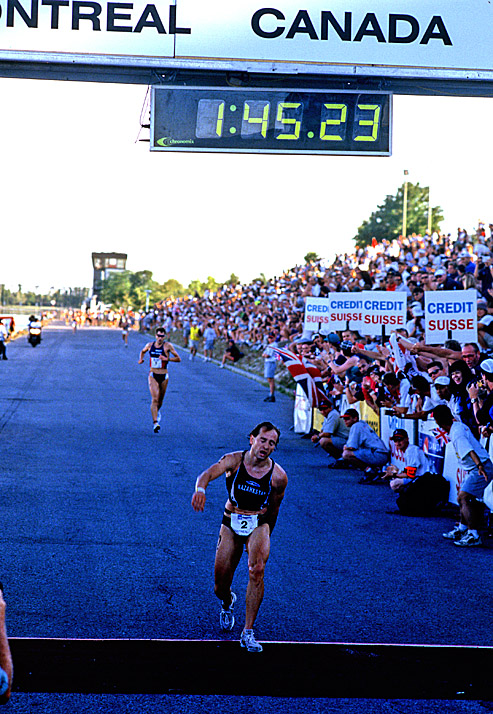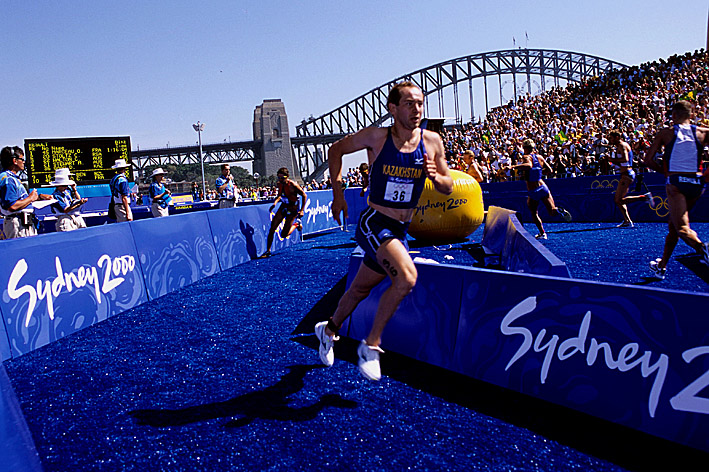Farewell Dimitry Gaag, World Cupper from Kazakhstan, we hardly knew ye

It is likely that no prominent Olympic distance triathlete who ever lived was as little known as Dimitry Gaag of Kazakhstan. And now, after his A and B sample at the 2008 Hy-Vee Triathlon tested positive for EPO, and he accepted a two-year ban by the International Triathlon Union, it is likely that we never will hear what this enigmatic and reclusive ethnic Russian from Borat’s country had to say about some of the biggest moments in the sport.
What is known about Gaag is that he was born March 20, 1971, in Karaganda, Kazakhstan, a major mining city of the former Soviet Socialist Republic which supplied coal to the industrial centers in the Urals. Given its coal mining background, Karaganda is known as The Black City. Established in 1934, much of it was built by forced labor which constructed steel, iron and cement plants. It is the second largest city of Kazakhstan, and has some cultural points of interest — a Stanislavsky Theater, a beautiful cathedral, a mosque, a government hotel and a tourist hotel built in the style of similar modern East German hotels in Berlin made for Communist Party bigwigs.
Always a great runner, Gaag started his athletic career in the military as a modern pentathlete and mastered fencing, equestrian, shooting as well as swimming and running. By the age of 22, he began triathlon, finishing 19th in the July 4,1993 Echtemach ETU Triathlon European Championships, and 14th a year later in the same event. In 1995, he finished 10th at the Stockholm European Championships, and finished 8th at the ITU World Championships in Cancun. On June 30, 1996, Gaag won his first of four career World Cups in Hamilton, Bermuda.
Once he became an elite modern pentathlete, Gaag lived and trained in Hungary, a hub of modern pentathlon. When he started his 16-year triathlon career, Hungary remained his primary European base.
Before he was busted for EPO in West Des Moines, Iowa, on June 20, Gaag scored ITU World Cup wins in Hamilton in 1996, Rio in 2000, Tongyeong, South Korea in 2004, and at his favorite World Cup in Tiszaujvaros, Hungary in 2005. At the end of a remarkably anonymous career, he had amassed 10 silvers — second places at Monte Carlo and Cancun in 1997, Gamagori and Tiszaujvaros in 1998, Lausanne in 1999, Tiszaujvaros in 2001 and 2003, and Ishigaki, Mazatlan and Gamagori in 2004. He also acquired eight more World Cup bronzes before the ITU took away his final third place medal at Tiszaujvaros in 2008 due to the EPO positive.
Gaag’s biggest moment came at the 1999 ITU World Championship. There, he took down the godlike Simon Lessing, he of the still unmatched four ITU Olympic distance World titles, like the Road Runner blazing past Wile E. Coyote with a fast final sprint whose essence was captured by Thierry Deketelaere’s haunting picture of Simon Lessing looking puzzled, glancing back over his shoulder with 500 meters to go on path along the Montreal Olympic rowing amphitheater. Probably Lessing had no idea who it was. He had already polished off present and future stars like Greg Welch, Brad Beven, Hunter Kemper, Miles Stewart, Simon Whitfield, Stefan Vuckovic, and Hamish Carter – the established, three-sport rivals he had come to enjoy competing with in true time trial format racing. But this day he became irrevocably fed up with the mass packs that formed with draft legal rules on that flat Formula One racing circuit Gilles Villeneuve and elsewhere. When Dimitry Gaag went by, this was the last straw for Lessing and ITU racing — except for the 2000 Olympics. Triathletes can just sit in the pack and do nothing on the bike and wait for the 10k, said Lessing. His point was that from that point onward, anonymous men who didn’t have to master the bike could win at draft legal, short course triathlon. And in his mind, Dimitry Gaag was the emblem of that category.

Gaag passed Lessing like a locomotive with 500 meters to go. Luckily, the short and muscular Gaag had 80 meters in hand on the tall and regal Lessing, who had gone into a surrender trot, when the Kazakh was hit by a painful leg cramp at the line. Far from the usual look of ecstatic joy, Gaag looked like a soldier who had been shot in the leg at his moment of triumph.
The next year, Gaag contended at the Sydney Olympics, but finished one spot out of the medals. Taking dead aim at the Athens Olympics in 2004, Gaag was an even bigger medal favorite after scoring three World Cup silver medals and a bronze at the ITU World Championship in Madeira Portugal. But on the day where ambitions were burned to cinders on the super steep hill on Vouliagmeni’s bike course, Gaag crumbled to a 23rd place finish. If anyone were to ask Simon Lessing, he’d probably tell you that Gaag was never a true three sport triathlete and that of course Athens’ hill would have unmasked him as a 10k runner in triathlete’s clothing.
Gaag and the Kazakhstan triathlon federation fought to have a final appeal of his doping ban delayed until after the Beijing Olympics, but it was denied. Gaag will be 39 years old before he can race World Cups again. The effect is much like Jurgen Zack’s positive at Frankfurt prior to his planned farewell at age 40 to the Ironman. The door will hit Dimitry Gaag on the backside on his way out of the sport, too.
Now, Dimitry Gaag’s remarkable record will, in many eyes, be consigned to the dustbin of tri-history. It will be filed in a kind of mental invisible purgatory in the same cabinet with other convicted sports drug cheats — Nina Kraft’s Ironman Hawaii win, Brigitte McMahon’s surprise Olympic gold, and fake world records by disgraced sprinters like Tim Montgomery, Marion Jones and Ben Johnson. No matter that Kraft never tested positive before her 2004 EPO bust, and neither did Brigitte McMahon until her bust for EPO in training five years after Sydney,. And neither did Gaag test positive until the 16th year of his career, dreaming of a third shot at the Olympics at the advanced age of 37.
Once they were proven drug cheats, all mental pictures of them with their ill-gotten golds receive a virtual Stalinesque Photoshop erasure, a one way ticket to the Invisible Gulag of Performance Enhanced Fakers.
Still, it would have been an interesting to talk to Dimitry Gaag, even through a clumsy interpreter, to see what he was thinking during his long journey through triathlon. But he was never one to stay around for interviews, which would have required an interpreter.
All that is left for most of us are impressions – surely silly exaggerations of the real man who trained the hard miles over long hours without comment or complaint. All the outside world could glean of the pain of the man within was a single line from his spare biography. Divorced.
Unlike the open joyousness of a Simon Whitfield, or the dry wit of Lessing, or the happy clowning of Greg Welch — all of whom were so willing to share with the world – Gaag’s mien was that of a secret agent behind enemy lines. His serious face acted like dark shades keeping the world at bay. He had a tragic look that transcended sport and was an echo of the Cold War.
Now, if you want to remember the best about Gaag – his powerful perfect stride at top speed that should have been recorded on a Greek frieze – it seems necessary to find a plausible, forgivable scenario. Perhaps he grew up in that part of the world where sportsmen were grim soldiers of a culture of doping national programs. Or perhaps, you may imagine, he was like Brigitte McMahon, desperate to hang on to sponsors to pay his bills, and finally succumbing to the temptation to hang on for one more run at the Olympic rings.
Otherwise, the pain of his offense to all his competitors may make all of us wish to simply forget the poetry of his stride, and submit the mysterious memories of the Flying Kazakh to the mind-cleansing embraced by Jim Carrey’s character in The Eternal Sunshine of the Spotless Mind.


Start the discussion at slowtwitch.northend.network